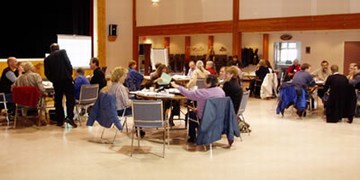Big Ideas for Small Communities

Sustainable development is a global concern. It is easy to picture, on a large scale, how human civilization affects the availability of natural resources and the condition of our planet”s environment. In small communities, the need for sustainable development is sometimes less apparent – but the pressures are every bit as real. That”s why it is also important to adopt sustainable planning and development practices. And it is why the Canada Mortgage & Housing Corporation (CMHC) has developed Big Ideas for Small Communities, a pilot workshop program that is designed specifically for municipal decision makers.
In October 2004, representatives from the Caribou Regional District and six Central Interior municipalities – Prince George, Quesnel, Williams Lake, 100 Mile House, Wells and Mackenzie – participated in a full-day, highly interactive workshop that was hosted by the City of Quesnel.
The Big Ideas workshop features numerous examples of succcessful practices from municipalities within BC and across Canada. It provides tools that local governments can use to move their communities toward greater sustainability. It also provides an excellent forum for the sharing of ideas and solutions from other communities.
A principal focus of the Quesnel Workshop was on the Water Balance Model. Kim Stephens, Project Coordinator for the Inter-Governmental Partnership, made a presentation titled Design with Nature: Integration of Water Management with Landscape Development. 'The Quesnel workshop provided a timely opportunity to test the relevance of the “water balance messaging” in a Smalltown BC context', commented Stephens. 'The ensuing discussion during the interactive session confirmed that small communities are tuned into the big picture and recognize the need for changes in land development practices', added Stephens.
The presentation by Stephens featured the Water Balance Model in the context of the Water Sustainability Action Plan for British Columbia. The Water Balance Model is the centrepiece of six Action Plan Elements that are comprehensive in scope and range from “governance” to “site design”. According to Stephens, 'the intent of the Action Plan is to influence choices and encourage action by individuals and organizatons – so that water resource stewardship will become an integral part of land use and daily living.'
First posted on the Water Balance Model website in November 2004

